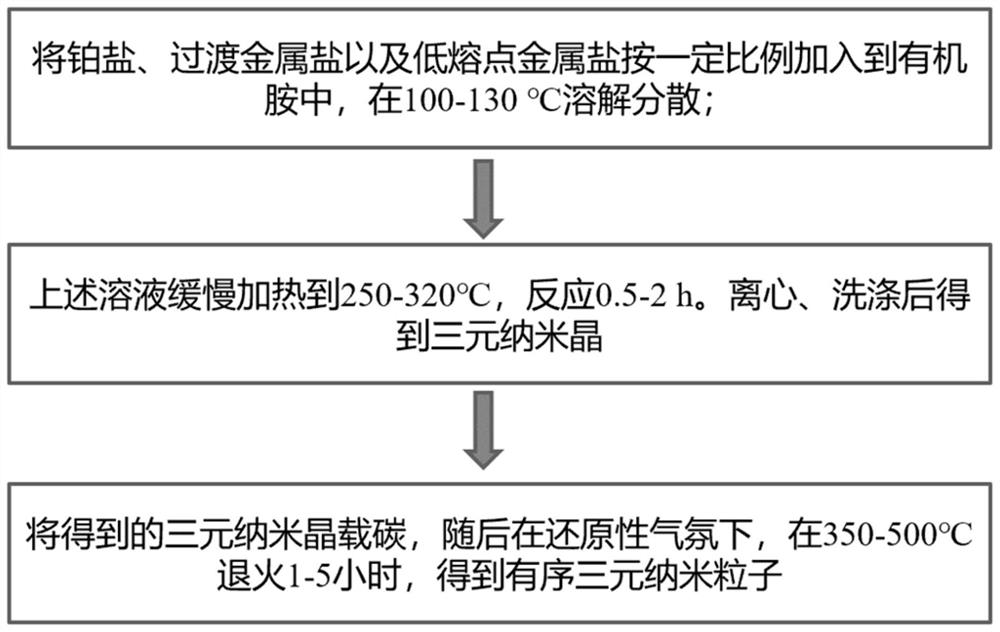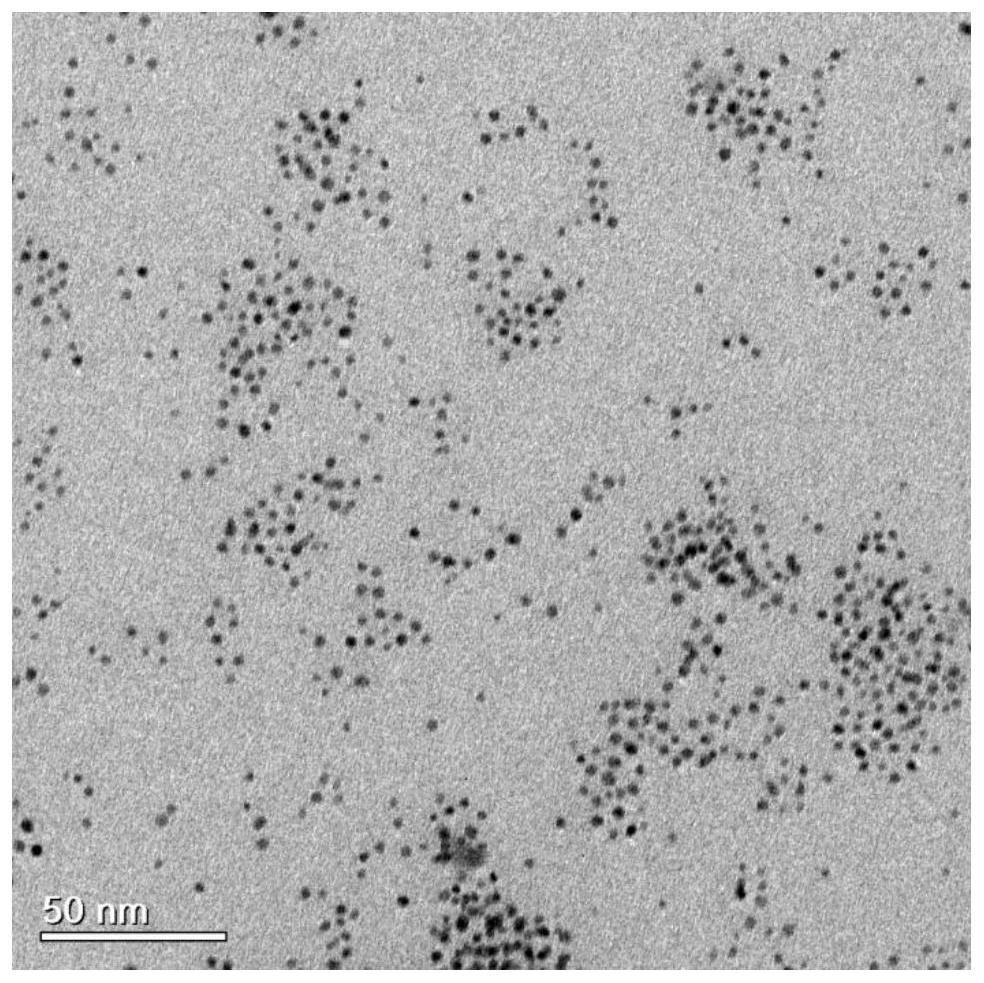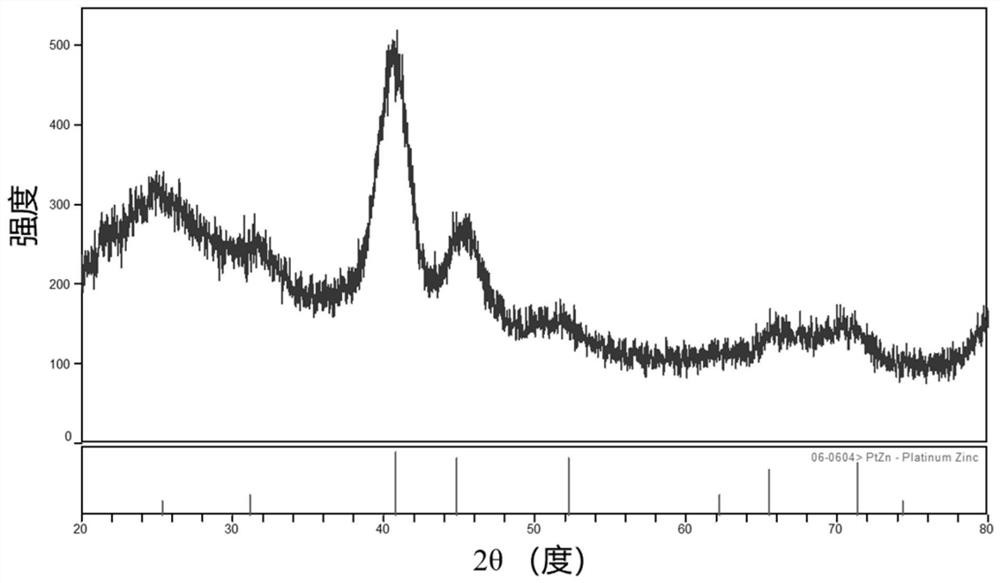Platinum-based intermetallic nanocrystal with ordered structure and low-temperature preparation and application thereof
A technology with an ordered structure and nanocrystals, applied in structural parts, nanotechnology, nanotechnology, etc., can solve the problems of reduced electrochemical specific surface of catalyst nanoparticles, easy dissolution of transition metals, and high energy consumption of technical routes. Achieve the effects of increased electrochemical active area, easy industrialization, and smaller size
- Summary
- Abstract
- Description
- Claims
- Application Information
AI Technical Summary
Problems solved by technology
Method used
Image
Examples
Embodiment 1
[0045] S1: According to the molar ratio of 5:4:1, take platinum acetylacetonate, zinc acetylacetonate and dibutyl tin diacetylacetonate, and dissolve them in 5 mL of oleylamine solution to make the platinum precursor concentration 0.01mol / L The solution. Under the protection of argon, the solution was stirred at 110 °C for 20 minutes, and the precursor salt was fully dissolved and mixed.
[0046] S2: Subsequently, the temperature of the solution was raised to 320° C. at a heating rate of 10° C. / min, and the reaction was continued for 2 hours, followed by centrifugal washing to obtain disordered platinum-zinc-tin nanoparticles.
[0047] S3: Weigh a certain mass of carbon powder according to the metal loading of 15%, add a mixture of ethanol and hexane with a volume ratio of 2:1, and ultrasonically disperse, and then slowly drop into the disordered platinum-zinc-tin-tricarbonate obtained in step S2 meta-nanoparticles. After ultrasonication for a period of time, centrifuge, was...
Embodiment 2
[0050] S1: According to the molar ratio of 50:35:15, take platinum acetylacetonate, nickel acetylacetonate and dibutyl tin diacetylacetonate, and dissolve them in 5 mL of oleylamine solution to make the platinum precursor concentration 0.05 mol / L The solution. Under the protection of argon, the solution was stirred at 100 °C for 20 minutes, and the precursor salt was fully dissolved and mixed.
[0051] S2: Subsequently, at a heating rate of 5°C / min, the solution was heated to 260°C, and the reaction was continued for 1 hour, followed by centrifugal washing to obtain disordered platinum-nickel-tin ternary nanoparticles;
[0052] S3: Weigh a certain mass of carbon powder according to the metal loading of 20%, add a mixture of ethanol and hexane with a volume ratio of 2:1, and ultrasonically disperse, and then slowly drop into the disordered platinum nickel tin three meta-nanoparticles. After ultrasonication for a period of time, centrifuge, wash, and dry to obtain carbon-suppo...
Embodiment 3
[0055] S1: According to the molar ratio of 50:45:5, take platinum acetylacetonate, iron acetate and dibutyl tin diacetylacetonate, and dissolve them in 5 mL of oleylamine solution to make a platinum precursor concentration of 0.01mol / L solution. Under the protection of argon, the solution was stirred at 130 °C for 20 minutes, and the precursor salt was fully dissolved and mixed.
[0056] S2: Subsequently, at a heating rate of 5°C / min, the temperature of the solution was raised to 260°C, the reaction was continued for 1 hour, and then centrifuged and washed to obtain disordered platinum-iron-tin ternary nanoparticles;
[0057] S3: Weigh a certain mass of carbon powder according to the metal loading of 10%, add a mixture of ethanol and hexane with a volume ratio of 2:1, and ultrasonically disperse, then slowly drop into the disordered platinum-iron-tin tricarbonate obtained in step S2 meta-nanoparticles. After ultrasonication for a period of time, centrifuge, wash, and dry to ...
PUM
| Property | Measurement | Unit |
|---|---|---|
| melting point | aaaaa | aaaaa |
| diameter | aaaaa | aaaaa |
| particle diameter | aaaaa | aaaaa |
Abstract
Description
Claims
Application Information
 Login to View More
Login to View More - R&D
- Intellectual Property
- Life Sciences
- Materials
- Tech Scout
- Unparalleled Data Quality
- Higher Quality Content
- 60% Fewer Hallucinations
Browse by: Latest US Patents, China's latest patents, Technical Efficacy Thesaurus, Application Domain, Technology Topic, Popular Technical Reports.
© 2025 PatSnap. All rights reserved.Legal|Privacy policy|Modern Slavery Act Transparency Statement|Sitemap|About US| Contact US: help@patsnap.com



